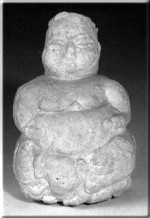Chalcholithic Age ( Copper Age) ( 5500-3000 BC)

In this period, in addition to stone tools copper pieces also come into sight. The need to change valuable goods (ceramics, textile) for both raw and shaped mines helped the trade develop, and this brought the exchange between peoples and the preparation of inventory listings with the beginning of communication. Symbols, hieroglyphs, writing with pictures, came into use. By the end of the 4000 BC cities emerged and the first steps of the human civilization were made.
Burdur-Hacilar level 5 ( 5500 BC) is the oldest site in Anatolia where metal objects are discovered. Regarding technique and forms; the handmade pottery production reached to an advanced level here and the single-colored, polished, ceramic pots were produced as an alternative to the metallic pots which were respectively more valuable. The surface of the pots is finely polished with a special technique to create a metallic effect.
One other important settlement area of the Chalcholithic period in Western Anatolia is the Beycesultan site, going back to 4000-3000 BC, located on the 5 km southeast of town of Civril in Denizli, excavated by Seton Lloyd. Here, some of the mud-brick structures with a rectangular plan look like long megaron houses (megaron is a long and narrow room that has a hearth in the center). Inside the structures are hearths, seats along the walls and storage. Here, in a pot, is discovered a collection of silver and copper rings, part of a dagger and metallic pins. The ceramic of this period has a background of gray, black and brown.
Canhasan site, on the 13 km northeast of Karaman town in Konya, unearthed by David French was a bridge between west and east Anatolia and Mesopotamia for trade and cultural exchange. Copper rings and bracelets are among the most important finds here. Anatolia which had the most advanced culture on earth during the Paleolithic period has lost its leadership in the Chalcolithic period to Mesopotamia and Egypt, after writing was discovered there Due to the fact that writing got to be used in Anatolia a thousands years later, the level of culture here could not go beyond that of Neolithic period primitive village, even though people were using metal in daily life.
